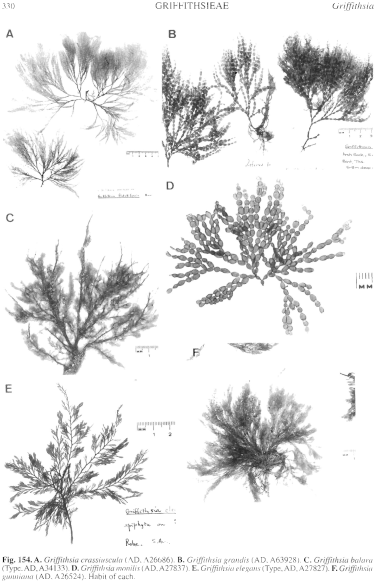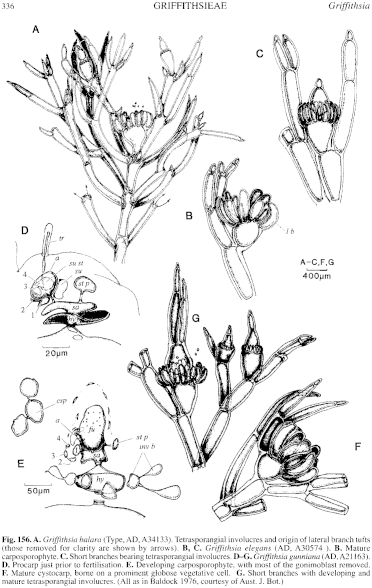|
|
|
|
|
|||||||||||
|
Electronic Flora of South Australia Species Fact Sheet
Phylum Rhodophyta – Order Ceramiales – Family Ceramiaceae – Tribe Griffithsieae
Selected citations: Baldock 1976: 531, figs 28–31, 80. De Toni 1903: 1273. Guiler 1952: 95. Lucas 1909: 48; 1929a: 24; 1929b: 52. Lucas & Perrin 1947: 326. Sonder 1881: 11. Tisdall 1898: 502.Wilson 1892: 186.
Thallus (Fig. 154F) medium to dark red-brown, branching essentially radial, tufted, 2.5–19 cm high, near the thallus apex subdichotomous, near the thallus base laterals sparse and spreading ("twiggy"); lower axes twisted together, with decurrent descending rhizoids, in larger plants forming a loosely woven, rope-like mass of filaments 2–10 mm in diameter. Attachment by rhizoids from the base; epiphytic, often on seagrass, or epilithic. Structure. Cells near the thallus apex cylindrical, 140–200 µm in diameter and L/D 2–4, in mid thallus cylindrical, 550–760 Rtri in diameter and L/D 3–4, axial cells in the lower thallus usually obscured by rhizoids.
Reproduction: Gametophytes dioecious. Female axes 3-celled, subapical, displaced laterally by the continued growth of the vegetative axis, flanked by a pair of hair-like synchronic laterals; procarp systems (Fig. 156D) subapical, each with a sterile lateral cell and a supporting cell with a terminal sterile cell and recurved, 4-celled carpogonial branch laterally; hypogenous cell producing abaxially 10–12 synchronic, 2-celled involucral branches, the lower cells small, ovoid, occasionally dividing subdichotomously (Fig. 156E), the terminal cells large, incurved, elongate to reniform, 270–420 µm in diameter and L/D 2.3–2.6; subhypogenous cell becoming globose, 730–860 µm in diameter (Fig 156F), adjacent vegetative branch forced to a lateral position by the expanding carposporophyte and similar in size to involucral cells; post-fertilisation fusion cell (Fig. 156E), bearing 1–3 gonimolobes terminally, most cells of which become ovoid carposporangia, 30–40 µm in diameter. Spermatangia borne on whorls of minute polychotomous fascicles from the upper shoulders of pyriform subapical cells 560–680 µm in diameter and L/D 1.2–1.6, which produce separately a whorl of 15–20 single-celled synchronic branches of elongate incurved cells, 150–200 µm in diameter and L/D 2–4, that enclose the spermatangial masses in a palisade-like involucre; vegetative apical cells above the clusters obpyriform, continuing growth, forming narrow filaments of 1–4 cells, often subdichotomous (as in Fig. 156G for tetrasporangial structures), the filaments with basal swollen cells usually caducous, the spermatangial masses then appearing terminal on pyriform cells surrounded by cupulate involucres.
Tetrasporangia lachrimiform, 40–70 µm in diameter, produced successively in groups of 3–8 on minute, terete pedicels arising in whorls from the upper shoulders of pyriform subapical vegetative cells 660–820 µm in diameter (Fig 156G), each bearing apically an obpyriform cell, a narrow filament of 1–4 cells often subdichotomous, and from the upper shoulder a whorl of 15–23 elongate, incurved, 1-celled, synchronic, involucral branches, 130–170 µm in diameter and L/D 3–4, enclosing the cluster; vegetative cells above the clusters often lost so that a cupulate structure remains.
Type from Georgetown, Tasmania (Gunn); holotype in Herb. Agardh, LD, 19793.
Selected specimens: Point Avoid, S. Aust., drift (Womersley, 2.xii.1975; AD, A46910). West I., S. Aust., 22m deep (Shepherd, 3.i.1966; AD, A30320). Victor Harbor, S. Aust., on Amphibolis (Womersley, 13.vii.1963; AD, A26524). Port Elliott, S. Aust., on seagrass, drift (Womersley, 10.viii.1957; AD, A21163). Cape Jaffa, S. Aust., drift (Womersley, 7.xii.1995; AD, A64569). Robe, S. Aust., upper sub-littoral, on Heterozostera (Womersley, 15.ix.1994; AD, A63556). Cape Northumberland, S. Aust., 15m deep (Shepherd, 9.ii.1977; AD, A55212). Low Head, Tas., 2–10m deep (Perrin, v.1945; AD, A8497). Georgetown, Tas., upper sub-littoral (Womersley, 29.i.1949; AD, A10297).
Distribution: Eyre Pen. to SE S. Aust., and around Tasmania.
Taxonomic notes: G. gunniana agrees with the Griffithsia antarctica group in its tufted thallus, and slender filaments, and reproductively in carposporophytes with cupulate involucres borne on swollen vegetative cells. Spermatangial and tetrasporangial clusters in this group lie in the constrictions between pairs of swollen cells, the basal member of which produces also a palisade-like whorl of involucral cells independent of the fascicles.
Some specimens with sparse branching resemble sterile plants of G. teges, but the texture of G. gunniana is softer, branching more tufted and filaments narrower than this species.
References:
AGARDH, J.G. (1876). Species Genera et Ordines Algarum. Vol. 3, Part 1- Epicrisis systematic Floridearum, pp. i-vii, 1–724. (Weigel: Leipzig.)
BALDOCK, R.N. (1976). The Griffithsieae group of the Ceramiaceae (Rhodophyta) and its southern Australian representatives. Aust. J. Bot. 24, 509–593.
DE TONI, G.B. (1903). Sylloge Algarum omnium hucusque Cognitarum. Vol. 4. Florideae. Sect. 3, pp. 775–1521 + 1523–1525. (Padua.)
GUILER, E.R. (1952). The marine algae of Tasmania. Checklist with localities. Pap. Proc. R. Soc. Tasmania 86, 71–106.
LUCAS, A.H.S. & PERRIN, F. (1947). The Seaweeds of South Australia. Part 2. The Red Seaweeds. (Govt Printer: Adelaide.)
LUCAS, A.H.S. (1909). Revised list of the Fucoideae and Florideae of Australia. Proc. Linn. Soc. N.S.W. 34, 9–60.
LUCAS, A.H.S. (1929a). The marine algae of Tasmania. Pap. Proc. R. Soc. Tasm. 1928, 6–27.
LUCAS, A.H.S. (1929b). A census of the marine algae of South Australia. Trans. R. Soc. S. Aust. 53, 45–53.
SONDER, O.W. (1881). In Mueller, F., Fragmenta Phytographiae Australiae. Supplementum ad volumen undecinum: Algae Australianae hactenus cognitae, pp. 1–42, 105–107. (Melbourne.)
TISDALL, H.T. (1898). The algae of Victoria. Rep. 7th Meet. Aust. Ass. Adv. Sci., Sydney, 1898, pp. 493–516.
The Marine Benthic Flora of Southern Australia Part IIIC complete list of references.
Publication:
Womersley, H.B.S. (24 December, 1998)
The Marine Benthic Flora of Southern Australia
Rhodophyta. Part IIIC. Ceramiales – Ceramiaceae, Dasyaceae
©State Herbarium of South Australia, Government of South Australia
Illustrations in Womersley Part IIIA, 1998: FIGS 154F, 156 D–G.

Figure 154 enlarge
Fig. 154. A. Griffithsia crassiuscula (AD, A26686). B. Griffithsia grandis (AD, A63928). C. Griffithsia balara (Type, AD, A34133). D. Griffithsia monilis (AD, A27837). E. Griffithsia elegans (Type, AD, A27827). F. Griffithsia gunniana (AD, A26524). Habit of each.

Figure 156 enlarge
Fig. 156. A. Griffithsia balara (Type, AD, A34133). Tetrasporangial involucres and origin of lateral branch tufts (those removed for clarity are shown by arrows). B, C. Griffithsia elegans (AD, A30574 ). B. Mature carposporophyte. C. Short branches bearing tetrasporangial involucres. D–G. Griffithsia gunniana (AD, A21163). D. Procarp just prior to fertilisation. E. Developing carposporophyte, with most of the gonimoblast removed. F. Mature cystocarp, borne on a prominent globose vegetative cell. G. Short branches with developing and mature tetrasporangial involucres. (All as in Baldock 1976, courtesy of Aust. J. Bot.)

|
Email Contact: State Herbarium of South Australia |

|